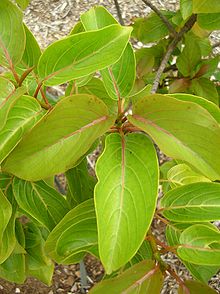- Colubrina oppositifolia
-
Colubrina oppositifolia 
Conservation status Scientific classification Kingdom: Plantae (unranked): Angiosperms (unranked): Eudicots (unranked): Rosids Order: Rosales Family: Rhamnaceae Genus: Colubrina Species: C. oppositifolia Binomial name Colubrina oppositifolia
Brongn. ex H.MannColubrina oppositifolia, known as Kauila in Hawaiian, is a species of flowering tree in the buckthorn family, Rhamnaceae, that is endemic to Hawaii. It can be found in dry, coastal mesic, and mixed mesic forests at elevations of 240–920 m (790–3,020 ft) on the islands of Oʻahu (Waiʻanae Range) and Hawaiʻi (slopes of Kohala, Hualālai, and Mauna Loa). There is also one individual remaining on Maui.[1] Associated plants include alaheʻe (Psydrax odorata) and ʻohe kukuluāeʻo (Reynoldsia sandwicensis).
Contents
Description
This tree reaches a height of 5–13 m (16–43 ft).[2] The trunk is coated in shredding gray-brown bark and the smaller twigs are reddish. The leaves are oppositely arranged and have pointed oval blades. The yellow-green flowers occur in clusters of 10 to 12. The fruit is a rounded capsule which is explosively dehiscent.[3]
Uses
Native Hawaiians valued the hard wood of C. oppositifolia and that of a related species, Alphitonia ponderosa, both of which were known as kauila. Consequently, the exact usage of C. oppositifolia wood is unknown. It is believed to have been used in pou (house posts), hohoa (round kapa beaters), ʻiʻe kūkū (square kapa beaters), ʻō (harpoons), hiʻa kā ʻupena (fishing net shuttles), ihe paheʻe (javelins), pololū (spears), pāhoa (daggers), lāʻa pālau (clubs), leiomano (shark tooth clubs), ʻōʻō (digging sticks), pieces for ʻume (a wand game), and ʻūkēkē (musical bows).[4]
Conservation
This tree has become rare in the wild. Once a dominant species of the forests it inhabits, it has now been reduced to no more than 300 wild individuals. Threats to the species have included introduced plant species, feral pigs and goats, rats, and the black twig borer (Xylosandrus compactus). The hard wood made it valuable to people, who overharvested it.[1] This is a federally listed endangered species of the United States.
See also
References
- ^ a b Bruegmann, M. M. & V. Caraway. (2003). Colubrina oppositifolia. IUCN Red List of Threatened Species. IUCN 2010. www.iucnredlist.org. Retrieved on 14 February 2011.
- ^ "Colubrina oppositifolia". CPC National Collection Plant Profiles. Center for Plant Conservation. http://www.centerforplantconservation.org/collection/CPC_ViewProfile.asp?CPCNum=1033. Retrieved 2009-11-13.
- ^ Colubrina oppositifolia. Hawaiian Native Plant Propagation Database, University of Hawaii, Manoa.
- ^ "kauila, kauwila". Hawaiian Ethnobotany Online Database. Bernice P. Bishop Museum. http://www2.bishopmuseum.org/ethnobotanydb/resultsdetailed.asp?search=kauila_C. Retrieved 2009-11-13.
External links
 Media related to Colubrina oppositifolia at Wikimedia Commons
Media related to Colubrina oppositifolia at Wikimedia Commons  Data related to Colubrina oppositifolia at Wikispecies
Data related to Colubrina oppositifolia at Wikispecies
This Rhamnaceae article is a stub. You can help Wikipedia by expanding it.

